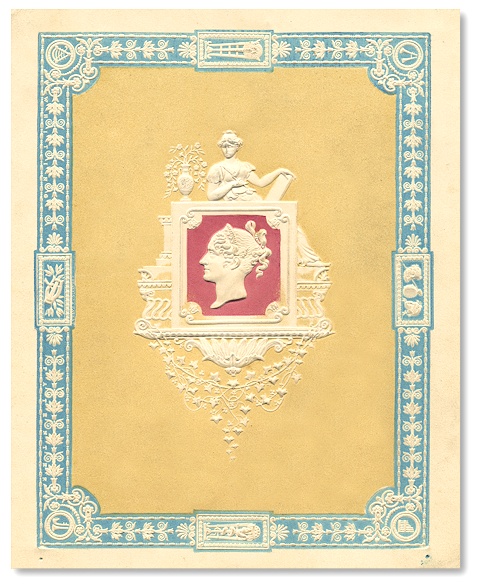 |
|
| News About Us Membership Events Links |
|
Embossed Portrait
A major undertaking, by Charles Whiting, was a series of souvenir portaits of notabilities of the period. The series presented blind-embossed portrait profiles on coloured backgrounds with blind-embossed frames. The portraits are of William IV, Queen Adelaide, Duke of Wellington, Earl Grey, Lord Brougham, Lord Byron, Sir Walter Scott and Thomas Moore - the Irish musician and poet. All are superbly embossed on the off-white absorbent board typical of the process. The portraits commonly referred to as "the Whiting Portraits", were appartently produced with an eye to publicity for Whiting's company. There is no record of their actually being sold, although Kendall & Son of London published an album in which they were pasted on blank sheets. The title page Bears the legend Royal Cameo Scrap Book Embossed Heads. There is no record of printing quantities of these items, but it is to be noted that in at least three cases they served as give-aways, two with newspapers and another with a magazine. Copies were presented to readers of The Age and The Atlas and the Walter Scott item carries, within the frame "Presented gratis with 1st number of The Story Teller, or Journal of fiction". Above extracted from "Embossing and Lace-Paper Production" by Maurice Rickards; The Ephemerist, No 92 March 1996, pages 630-631. In the same issue Valerie Jackson-Harris noted the border to the cameo of Queen Adelaide is landscape while her image is portrait. Henry Dobbs, a company identified with high quality embossing, is not credited but it is widely accepted that the quality of the dies and the style of the decorative frames leaves little doubt that Dobbs was their origin. Pasted on the reverse of the above portrait of Queen Adelaide is a small label: "This Cameo is presented to the subscribers of The Story-Teller, or Journal of Fiction, a weekly publication, price 6d containing original and selected tales, compiled from the works of the highest native and foreign talent; each number averaging about six tales, which occupy 36 pages, equal in quantity to the contents of the ordinary octavo volume of a novel".
|
|
|
Home | News | About Us | Membership | Events | Links | Contact | Item of the month | Articles |
| Copyright © The Ephemera Society 2025. All Rights Reserved. |

